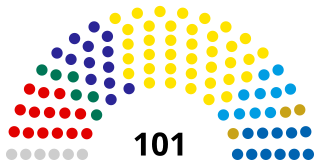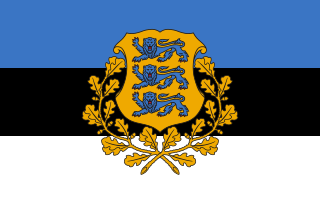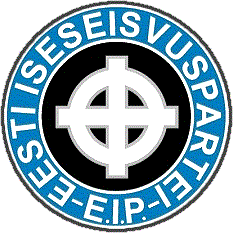Related Research Articles

The Riigikogu is the unicameral parliament of Estonia. In addition to approving legislation, the Parliament appoints high officials, including the prime minister and chief justice of the Supreme Court, and elects the president. Among its other tasks, the Riigikogu also ratifies significant foreign treaties that impose military and proprietary obligations and bring about changes in law, as well as approves the budget presented by the government as law, and monitors the executive power.

The president of the Republic of Estonia is the head of state of the Republic of Estonia. The current president is Alar Karis, elected by Parliament on 31 August 2021, replacing Kersti Kaljulaid.

The Estonian Independence Party was a far-right nationalist political party in Estonia. The small party, founded in 1999, never had any significant success in the elections, and it was dissolved in 2022. One of the principal aims of the party was the withdrawal of Estonia from the European Union.
The Congress of Estonia was an innovative grassroots parliament established in Estonia in 1990–1992 as a part of the process of regaining of independence from the Soviet Union. It also challenged the power and authority of the pre-existing quasi-parliament in the country, called the Supreme Soviet of the Estonian SSR, which had been imposed on Estonia after the Soviet invasion, occupation and illegal annexation of Estonia in 1940. The Congress of Estonia declared that it represented the highest authority on questions of Estonian statehood and citizenship, deriving this authority from the consent and initiative of the citizens of Estonia. The aim of the Congress was to restore Estonian independence based on the principle of legal continuity, with the pre-1940 Republic of Estonia, which had been established in 1918, as the foundation.

Parliamentary elections were held in the Latvian SSR on 18 March 1990. It was the first free parliamentary election in Latvia since 1931 and saw 201 deputies elected to the Supreme Soviet of the Latvian SSR, 170 of them in the first round. Run-off elections were held on 25 March 1 and 29 April. The Popular Front of Latvia won over two-thirds of the vote. Unlike its Estonian and Lithuanian counterparts, the Latvian Communist Party did not separate from the Communist Party of the Soviet Union. Nonetheless, on 3 May 1990, the new Supreme Soviet re-elected the Communist Party member Anatolijs Gorbunovs as its chairman, effectively the leader of Latvia. He subsequently resigned from the party, and a year later the Communist Party was banned by the parliament.
Parliamentary elections were held in Estonia on 14 and 15 July 1940 alongside simultaneous elections in Latvia and Lithuania. The elections followed the Soviet occupation of the three countries. As was the case in Latvia and Lithuania, the elections in Estonia were blatantly rigged. They were also unconstitutional, since only seats for the lower chamber of the Riigikogu, the Chamber of Deputies, were contested; the upper chamber, the National Council, had been dissolved and was never reconvened. According to August Rei, one of independent Estonia's last envoys to Moscow, under the Estonian constitution, the Chamber of Deputies had "no legislative power" apart from the National Council.
Elections to the Supreme Soviet of the Estonian SSR were held on 16 February 1947. They were the first elections since the Estonian SSR was declared on 21 July 1940 and the first after World War II.
Elections to the Supreme Soviet of the Estonian SSR were held on 25 February 1951. The Bloc of Communists and Non-Party Candidates was the only party able to contest the elections, and won all 115 seats. Elected members included Joseph Stalin, Vyacheslav Molotov, Georgi Malenkov and Panteleimon Ponomarenko.
Elections to the Supreme Soviet of the Estonian SSR were held on 27 February 1955. The Bloc of Communists and Non-Party Candidates was the only party able to contest the elections, and won all 125 seats.
Elections to the Supreme Soviet of the Estonian SSR were held on 15 March 1959. The Bloc of Communists and Non-Party Candidates was the only party able to contest the elections, and won all 125 seats.
Elections to the Supreme Soviet of the Estonian SSR were held on 17 March 1963. The Bloc of Communists and Non-Party Candidates was the only party able to contest the elections, and won all 178 seats.
Elections to the Supreme Soviet of the Estonian SSR were held on 13 June 1971. The Bloc of Communists and Non-Party Candidates was the only party able to contest the elections, and won all 183 seats.
Elections to the Supreme Soviet of the Estonian SSR were held on 15 June 1975. The Bloc of Communists and Non-Party Candidates was the only party able to contest the elections, and won all 200 seats.
Elections to the Supreme Soviet of the Estonian SSR were held on 24 February 1980. The Bloc of Communists and Non-Party Candidates was the only party able to contest the elections, and won all 285 seats.
Elections to the Supreme Soviet of the Estonian SSR were held on 24 February 1985. The Bloc of Communists and Non-Partisans was the only party able to contest the elections, and won all 285 seats.

Ülo Nugis was an Estonian politician and economist. As Speaker of the Supreme Council of Estonia on 20 August 1991, he presided over the Supreme Council's historic session when it voted for the restoration of Estonia's national independence from the Soviet Union.

The Supreme Soviet of the Estonian SSR was the formal rubber stamp legislative body of the Estonian SSR without any substantive meaning, which was formally elected in general elections, but whose members were essentially appointed by the leadership of the Communist Party. Before 1988, the Supreme Soviet had no meaningful political role. After its first democratic elections on 18 March 1990, the institution was renamed the Supreme Council of the Republic of Estonia on 8 May 1990.

August Liivik was an Estonian sport shooter.
References
- 1 2 Olev Liivik "Formation of the Supreme Soviet of the ESSR: Elections and the principles of assembling Archived 2013-10-04 at the Wayback Machine " Estonian Institute of Historical Memory, p4
- ↑ Liivik, p2